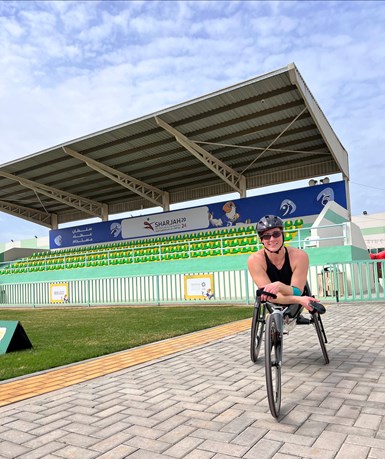Wheelchair racing glove demands met by CRP USA composites
The strength, durability and light weight characteristics of 3D printed Windform XT 2.0 athletic gear facilitates Paralympics Gold Medalist Tatyana McFadden’s enhanced agility and comfort.
CRP USA (Mooresville, N.C., U.S.), a 3D printing service bureau, has partnered with eight-time Paralympics Gold Medalist Tatyana McFadden to create 3D printed wheelchair racing gloves using selective laser sintering (SLS) and the company’s Windform XT 2.0 material, a carbon fiber-filled polyamide. According to CRP, this collaboration addresses significant manufacturing challenges and sets a new standard for elite athletic gear.
Wheelchair racing demands high performance from athletes due to the high friction generated by constant hand-wheel contact. Traditional gloves often fail to meet the standards required by athletes like McFadden. Before adopting CRP USA’s solution, she used standard mold kits for her gloves, finding the quality inadequate. Conventional methods struggled to produce gloves that could withstand the intense stress of wheelchair racing while maintaining precision and comfort.
“My first wheelchair racing gloves were called ‘harness gloves,’” recalls McFadden. “They were shaped like thumbs and made of heavy-duty fabric with rubber padding. Their softness made me feel the impact every time I hit the hand ring. By the 2008 Paralympic Games, my team and I began making hard gloves. We would take plastic beads, melt them in a pot of boiling water and then mold the plastic to my hands. This process took days to perfect. Sometimes, we would have to start over and throw the whole plastic glove back in the water. Once perfected, I did not let the gloves out of my sight because they would melt if left in the car or in the heat for too long. Over time, the plastic would wear down, so we made the gloves thick, but they were heavy.” Nonetheless, even these gloves were not up to McFadden’s needs.
In 2015, a significant change occurred when McFadden had the opportunity to experiment with 3D printed gloves. In 2016, she connected with CRP USA to continue developing 3D printing racing gloves, aiming for them to be “stronger and more durable” compared to what they were using in 2015.
Strength and durability were undoubtedly important characteristics that McFadden required from CRP USA to compete at her best, but they were not the only ones. Lightness, stiffness, resistance to wear and tear, and resistance to weather were other important features she wanted. “When I met with the CRP USA team,” McFadden specifies, “we also talked about heat, rubber, weather effects and straps for the gloves so they can stay in my hands better. When competing outside, we face various weather conditions, and I want to be ready for anything. My gloves have cracked in the past. My strokes produce a lot of force when I hit the hand ring, and my previous gloves lasted less than a year. I also wanted a better way to add rubber to the hand rings. The CRP USA team listened to my needs and managed to satisfy them in the best possible way.”
When competing outside, we face various weather conditions, and I want to be ready for anything.”
Before the construction of the parts, discussions with customers are essential. After several meetings with McFadden, the CRP USA team opted for SLS and Windform XT 2.0 as the manufacturing material. In this specific case, the rubber used in the 3D printed gloves is a standard off-the-shelf item. The CRP USA team trims it to size and bonds it to the gloves using a structural adhesive. This operation demonstrates the high professionalism of the CRP USA team and the compatibility of Windform XT 2.0 with various components, ensuring seamless bonding without any issues.
“Throughout her career, Tatyana found that the quality and detail of her gloves were just not up to the high standard she needed,” Nathan “Nate” Baker, senior project coordinator at CRP USA, explains. “That’s when the Windform range of composites for 3D printing, created by our Italian partner CRP Technology, came into play. At CRP USA, we have tried several different Windform materials for her, with the gold standard becoming Windform XT 2.0.”
Windform XT 2.0’s properties ensure the gloves can withstand the constant, high-friction environment of wheelchair racing without deterioration. This durability extends the lifespan of the gloves compared to traditional materials. Additionally, the flexibility and shock-absorbing properties of Windform XT 2.0 ensures maximum comfort, enabling McFadden to focus solely on her performance without discomfort or distraction.
CRP USA hollowed the parts out and inserted an internal structuring. This enabled weight reduction (approximately 100 grams, a 50% reduction from traditional gloves) while maintaining strength, integrity and improving durability — this became a significant contribution to McFadden’s agility and speed during races. Once completed, the 3D printed wheelchair racing gloves in Windform XT 2.0 underwent testing for weight and durability, with positive results.
“I remember using the gloves in Windform XT 2.0 for the very first time on the track and on the road,” McFadden says. “I was so impressed by how light and durable they were. My hands felt so light, it felt like I wasn’t holding onto anything. When I first put my hands into the glove, it was so smooth. They had also built in two holes where I could strap on the gloves to my hands instead of using additional clips.”
CRP USA and McFadden continue to collaborate to enhance the 3D printed wheelchair racing gloves, focusing on improving grip and comfort, especially when competing in the rain.
Related Content
Plant tour: Teijin Carbon America Inc., Greenwood, S.C., U.S.
In 2018, Teijin broke ground on a facility that is reportedly the largest capacity carbon fiber line currently in existence. The line has been fully functional for nearly two years and has plenty of room for expansion.
Read MorePEEK vs. PEKK vs. PAEK and continuous compression molding
Suppliers of thermoplastics and carbon fiber chime in regarding PEEK vs. PEKK, and now PAEK, as well as in-situ consolidation — the supply chain for thermoplastic tape composites continues to evolve.
Read MoreSulapac introduces Sulapac Flow 1.7 to replace PLA, ABS and PP in FDM, FGF
Available as filament and granules for extrusion, new wood composite matches properties yet is compostable, eliminates microplastics and reduces carbon footprint.
Read MoreNatural fiber composites: Growing to fit sustainability needs
Led by global and industry-wide sustainability goals, commercial interest in flax and hemp fiber-reinforced composites grows into higher-performance, higher-volume applications.
Read MoreRead Next
ATL Composites collaboration advances kite-foil board production for Paris Olympics
Breiana Whitehead, pioneering Australian kite-foil sailor, spearheads board design intricacies with ATL Composites to enhance her performance ahead of the July 2024 competition.
Read MoreSolvay supports record-holding athletes in Paris 2024 Paralympic Games
The Solvay 4 Sport partnership aligns with the group’s DEI program, which aims to cultivate an equitable and inclusive environment that embraces diversity.
Read MoreVIDEO: High-volume processing for fiberglass components
Cannon Ergos, a company specializing in high-ton presses and equipment for composites fabrication and plastics processing, displayed automotive and industrial components at CAMX 2024.
Read More



























